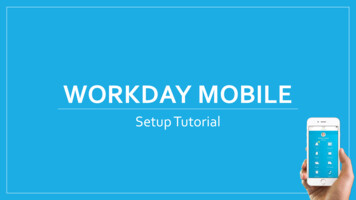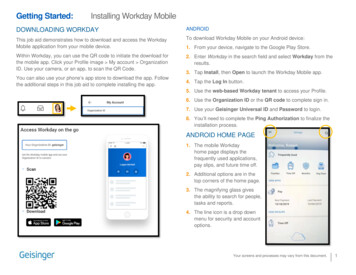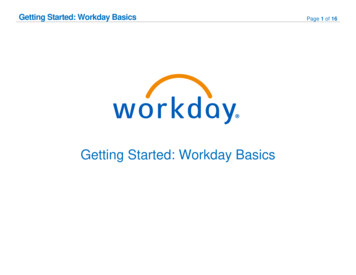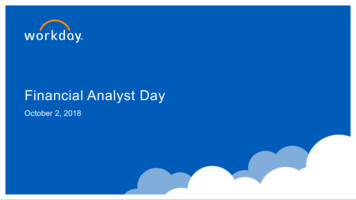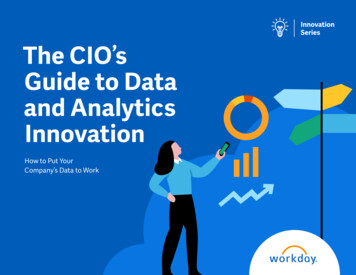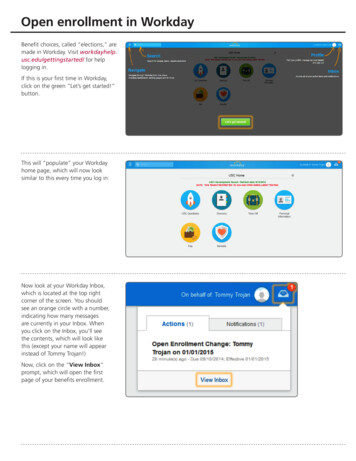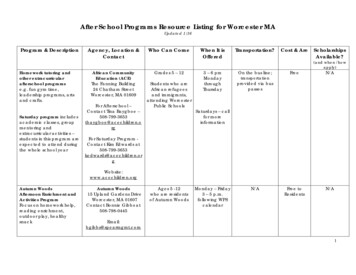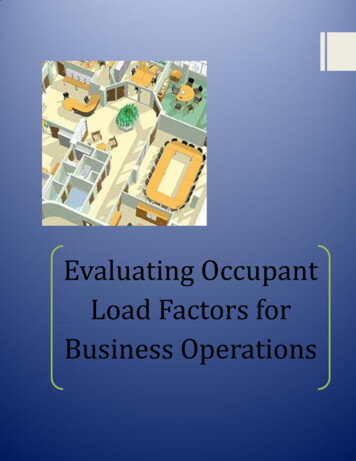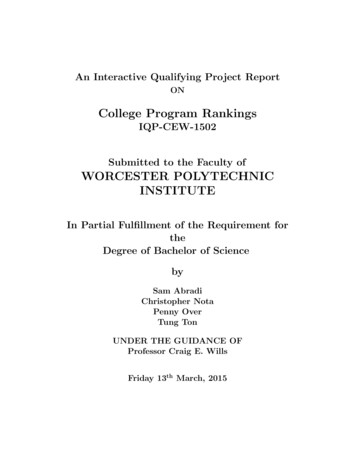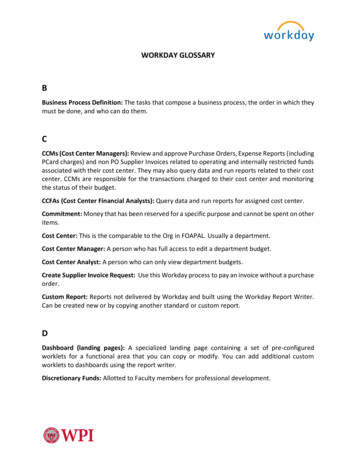
Transcription
WORKDAY GLOSSARYBBusiness Process Definition: The tasks that compose a business process, the order in which theymust be done, and who can do them.CCCMs (Cost Center Managers): Review and approve Purchase Orders, Expense Reports (includingPCard charges) and non PO Supplier Invoices related to operating and internally restricted fundsassociated with their cost center. They may also query data and run reports related to their costcenter. CCMs are responsible for the transactions charged to their cost center and monitoringthe status of their budget.CCFAs (Cost Center Financial Analysts): Query data and run reports for assigned cost center.Commitment: Money that has been reserved for a specific purpose and cannot be spent on otheritems.Cost Center: This is the comparable to the Org in FOAPAL. Usually a department.Cost Center Manager: A person who has full access to edit a department budget.Cost Center Analyst: A person who can only view department budgets.Create Supplier Invoice Request: Use this Workday process to pay an invoice without a purchaseorder.Custom Report: Reports not delivered by Workday and built using the Workday Report Writer.Can be created new or by copying another standard or custom report.DDashboard (landing pages): A specialized landing page containing a set of pre-configuredworklets for a functional area that you can copy or modify. You can add additional customworklets to dashboards using the report writer.Discretionary Funds: Allotted to Faculty members for professional development.
EEncumbrance: Money that has been reserved for a specific purpose and cannot be spent on otheritems.FFunctional Area: A collection of domain or business process security policies that are related tothe same set of product features, for example, Benefits or Compensation.GGift: Restricted funds, includes endowments.HHCM: Human Capital ManagementIInitiation Step: The first step of a business process.JJob Management Staffing Model: A structure that defines 1 set of hiring restrictions for all jobsin a supervisory organization, with no specific limits on the number of jobs that can be filled.Student employment is an example of this.Job Profile: The generic features and characteristics of a job or position, such as managementlevel, pay rate type, compensation, skills, and other qualifications.Job Requisitions: You can create job requisitions for unfilled positions in organizations that useposition or job management as the staffing model. For position management organizations, youcan create multiple job openings with a single job requisition if the requisition creates a newposition. You can have only 1 job requisition for an opening. For job management organizations,you can select multiple openings. You can't create job requisitions for frozen or closed positions.
LLanding Page: Landing pages display a collection of worklets. Landing pages may have differentdisplay formats (grid or bubble) and support different functions. The Home landing page isintended for common worklets, such as self-service worklets.Ledger Account: Item descriptions and spend categories roll up into ledger accounts whenviewing a budget.PPre-Hire: In Staffing, an individual you're tracking before employment. In Recruiting, a candidatewho is in the Offer or Background Check stage. Students are in Workday as pre-hires, so they canbe hire into positions.Procurement: Acquiring goods or services from an external source.Purchase Order (PO): A business document that is issued by a buyer and given to a supplier. Ithas the prices and details about the goods or services the buyer is ordering.QQuick Add: A time entry option that enables you to create a time block and copy it to multipledays in a week.RReceipt: receipts for goods, services, project-based services, and contingent worker timesheetson purchase order and supplier contract lines.Recruit (vs. Hire): Recruit means to post a job ad and look for candidates. Hire means to give acandidate a job.Requisition: Requesting goods and services for yourself or on behalf of another worker.Revenue Category: An attribute in customer contracts and billing used to search for and reporton goods and services you sell. Also, a dimension in account posting rule types for customercontracts, billing, and accounts receivable that drives accounting behavior.Roles: A grouping of people with specific responsibilities and permissions. In a business processruns, the role for each step includes all of the workers in that role in the business process targetorganization.
SSecurity Group: A collection of users or objects that are related to users. Security group accessto a securable item in a security policy grants access to the users associated with the securitygroup.Spend Category: A logical grouping to search and report on acquired items and services. Also, adimension in account posting rules for procurement and spend that drives accounting behavior.Standard Report: Reports developed by Workday and delivered to all Workday customers.Standard reports may be defined using the Workday Report Writer or in an internal developmenttool. Only Standard reports designed using the Report Writer can be copied to create a customreport and then modified.Supplier: Create suppliers to procure goods and services for your organization. Provide detailsfor managing supplier relations, payment terms, and reporting.Supplier Invoice Request: Create a payment request for goods or service lines in Workday byadding invoice information to the request. After Workday approves the payment requests, itautomatically converts them into supplier invoices.TTask: A step, either standalone or in business process, that you must complete. For example, taskalert notifications are triggered by steps in a business process.Tenant: A tenant is a unique instance of Workday that contains a set of data in a logicallyseparated database. Workday secures each tenant through password-controlled access. You canconfigure your tenant to meet your needs.Time Block: A time block carries information about a portion of time, such as the number of hoursworked or in/out times. Time blocks can be reported or calculated, but only calculated timeblocks are pulled into Workday Payroll.Time Entry Calendar: A set of self-service pages that workers use to enter, edit, and submit time,when using calendar-based time entry. When using high volume time entry, workers can viewand submit time from the time entry calendar.Time Off: The rules that apply to a specific type of time off, including eligibility rules, whetheradjustments are allowed, and limits that differ from the time off plan.
VView (business process): A securable item used to allow members to view status of a businessprocess and report on it. A securable item in a business process security policy.WWorklet: A compact report displayed as an icon (a tile or a bubble) on any landing page, providingeasy access to tasks and information that are used regularly. Examples: My Leadership Roles,Open Positions, and Anniversaries.Worktag: A named attribute that you can assign to events and objects to indicate their businesspurpose. For example, you can create a Customer worktag, whose values are the names of yourcustomers. You can use the worktag to assign a customer to an expense in an expense report ora product sales event.
blocks are pulled into Workday Payroll. Time Entry Calendar: A set of self-service pages that workers use to enter, edit, and submit time, when using calendar-based time entry. When using high volume time entry, workers can view and submit time from the time entry calendar.
